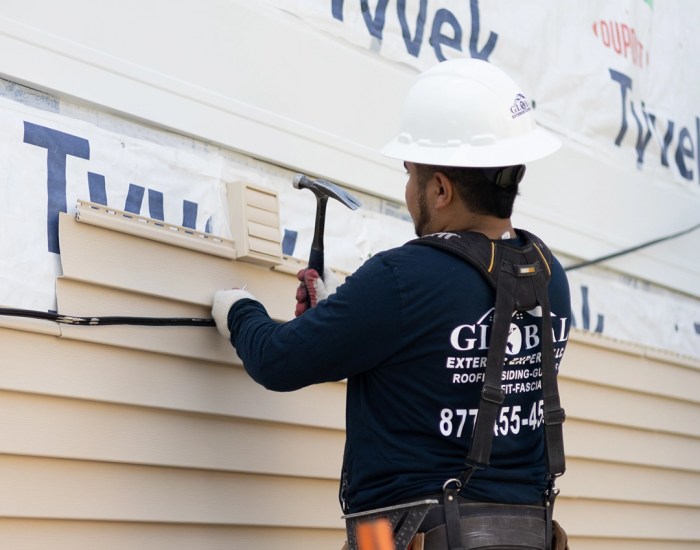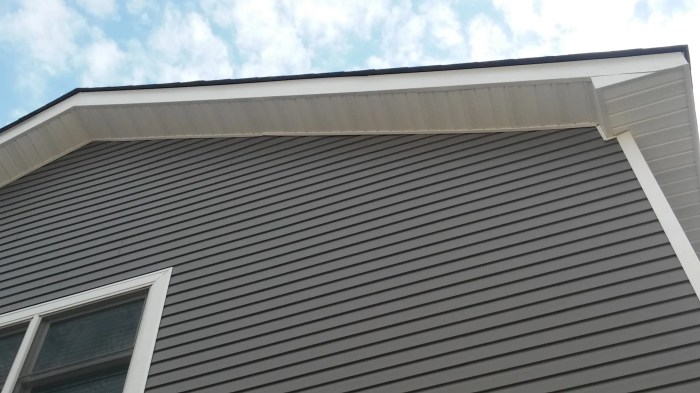Embark on a journey into the world of global siding and roofing, where the importance of quality materials meets the impact of climate, shaping buildings worldwide.
Delve into the various types of siding materials, roofing solutions, installation practices, trends, and environmental considerations that define this crucial aspect of construction.
Introduction to Global Siding and Roofing

Global siding and roofing are essential components of buildings worldwide. Siding refers to the exterior material applied to the walls of a structure, while roofing involves the materials used to cover and protect the top of a building. Quality siding and roofing are crucial for the durability, energy efficiency, and overall appearance of a property.
Importance of Quality Siding and Roofing
Quality siding and roofing play a significant role in protecting a building from elements such as rain, wind, snow, and sunlight. Proper installation of high-quality materials can enhance the structural integrity of a property, prevent water damage, and improve energy efficiency by regulating temperature and reducing heating and cooling costs.
Impact of Climate on Siding and Roofing Materials
The choice of siding and roofing materials is greatly influenced by the climate of a region. Areas prone to heavy rain may require waterproof materials such as vinyl siding or asphalt shingles to prevent water penetration. In regions with extreme temperatures, durable materials like metal roofing or fiber cement siding may be more suitable to withstand heat, cold, and humidity fluctuations.
Types of Siding Materials
When it comes to siding materials, there are several popular options used globally, each with its own set of pros and cons. Let's explore some of the common types of siding materials and their characteristics.
Vinyl Siding
- One of the most popular choices due to its affordability and low maintenance.
- Available in a wide range of colors and styles, making it versatile for different architectural designs.
- Resistant to rot, insect damage, and fading.
Fiber Cement Siding
- Known for its durability and resistance to fire, insects, and harsh weather conditions.
- Can mimic the look of wood, stucco, or masonry.
- Requires minimal maintenance but can be more expensive upfront.
Wood Siding
- Offers a natural, rustic appearance that can enhance the curb appeal of a home.
- Eco-friendly and biodegradable, making it a sustainable option.
- Requires regular maintenance to prevent rot, warping, and insect infestations.
Composite Siding
- Made from a combination of wood fibers and resin for a durable and low-maintenance option.
- Resistant to rot, splitting, and cracking.
- Available in various textures and finishes to resemble natural materials.
Recycled Plastic Siding
- An eco-friendly option made from recycled plastic materials.
- Durable, moisture-resistant, and long-lasting.
- Contributes to reducing plastic waste and promoting sustainability.
Roofing Solutions Around the World
Roofing solutions vary greatly around the world, influenced by climate, culture, and available resources. From traditional methods passed down through generations to modern technologies revolutionizing the industry, the global landscape of roofing is diverse and fascinating.
Traditional Roofing Solutions
Throughout history, different regions have developed unique roofing solutions to suit their specific needs. For example, in Japan, you can find intricately designed thatched roofs made from rice straw, known as "kayabuki." These roofs are not only beautiful but also provide excellent insulation and durability.
Modern Roofing Technologies
- One of the most innovative roofing materials today is solar tiles, which harness the power of the sun to generate electricity for homes and buildings. These tiles seamlessly integrate into the roof, offering a sustainable energy solution.
- Another modern technology gaining popularity is green roofs, where vegetation is grown on the roof surface. Not only do green roofs provide insulation and reduce energy costs, but they also help mitigate the urban heat island effect and promote biodiversity.
Sustainable Roofing Options
As the world becomes more environmentally conscious, sustainable roofing options are on the rise. Materials like recycled metal, reclaimed wood, and clay tiles are not only eco-friendly but also durable and aesthetically pleasing.
- Solar shingles, made from recycled materials and designed to mimic traditional roofing materials, are a sustainable alternative for homeowners looking to reduce their carbon footprint.
- Living roofs, covered in vegetation, are not only visually appealing but also provide natural insulation, absorb rainwater, and improve air quality.
Installation and Maintenance Practices
Installing siding and roofing properly is crucial for the longevity and effectiveness of these components. Regular maintenance is equally important to ensure they remain in optimal condition throughout their lifespan.
Best Practices for Installing Siding and Roofing
- Ensure proper alignment and secure attachment of siding panels or roofing materials to prevent leaks and damage.
- Follow manufacturer guidelines and recommendations for installation techniques and materials to guarantee durability.
- Use high-quality tools and equipment to achieve precise and accurate installation results.
Importance of Regular Maintenance for Siding and Roofing
Regular maintenance helps identify and address any potential issues early on, preventing costly repairs or replacements in the future.
Tips for Extending the Lifespan of Siding and Roofing Materials
- Clean siding and roofing regularly to remove debris and prevent mold growth.
- Inspect for any signs of damage or wear and tear, and address them promptly to avoid further deterioration.
- Trim nearby trees or branches to prevent damage from falling limbs or excessive shade that can promote moisture buildup.
Global Trends in Siding and Roofing
As the construction industry continues to evolve, so do the trends in siding and roofing. Let's explore the latest developments shaping the way we build and design our homes.
Design and Aesthetics
Design and aesthetics play a crucial role in the overall look and feel of a building. Today, there is a growing trend towards modern and sleek designs for siding and roofing. Clean lines, minimalistic styles, and bold colors are becoming increasingly popular among homeowners looking to give their homes a contemporary touch.
Architectural shingles are gaining popularity for roofing, offering a more upscale and textured appearance compared to traditional asphalt shingles.
Smart Technology Integration
The integration of smart technology in siding and roofing systems is revolutionizing the way we interact with our homes. From solar panels that seamlessly blend into roofing materials to smart sidings that regulate temperature and energy consumption, homeowners are embracing the convenience and efficiency that these technological advancements bring.
Smart ventilation systems in roofs can help improve indoor air quality and reduce energy costs by optimizing airflow.
Energy-Efficient Solutions
With a growing focus on sustainability and eco-friendliness, energy-efficient siding and roofing solutions are on the rise. Materials that offer better insulation, such as insulated vinyl siding and metal roofing, are becoming popular choices for homeowners looking to reduce their carbon footprint and energy bills.
Reflective roofing materials can help reduce heat absorption, lowering cooling costs during hot summer months.
Environmental Impact of Siding and Roofing

When it comes to siding and roofing materials, it is crucial to consider their environmental impact. The choices we make in construction can have long-lasting effects on the environment, so understanding the footprint of different materials is essential.
Environmental Footprint of Different Materials
Various siding and roofing materials have different environmental footprints. For example:
- Vinyl siding is known for its energy-intensive manufacturing process and contribution to pollution.
- Wood siding, while natural and renewable, can lead to deforestation if not sourced sustainably.
- Metal roofing is highly recyclable but may have a larger initial environmental impact due to production methods.
- Slate roofing has a long lifespan, but quarrying for slate can have negative impacts on local ecosystems.
Reducing Environmental Impact
There are several ways to reduce the environmental impact of siding and roofing installations:
- Choose materials with high recycled content or that are easily recyclable.
- Opt for products with long lifespans to reduce the frequency of replacements.
- Implement proper insulation to improve energy efficiency and reduce heating/cooling demands.
- Select materials sourced from sustainable forests or manufacturers with eco-friendly practices.
Promoting Sustainable Practices
Initiatives and regulations play a significant role in promoting sustainable siding and roofing practices:
- Green building certifications like LEED encourage the use of environmentally friendly materials.
- Government regulations may mandate certain energy-efficient standards for construction projects.
- Industry associations often provide guidelines for sustainable building practices.
- Consumer demand for eco-conscious products can drive manufacturers to adopt greener practices.
Closure
In conclusion, global siding and roofing play a vital role in the structural integrity and aesthetics of buildings worldwide. By understanding the nuances of materials, technologies, and environmental impacts, we pave the way for a sustainable future in construction.
Q&A
What are the benefits of using eco-friendly siding materials?
Eco-friendly siding materials help reduce environmental impact, improve energy efficiency, and enhance overall sustainability of buildings.
How often should siding and roofing be maintained?
Regular maintenance, typically once or twice a year, is crucial to prolong the lifespan of siding and roofing materials.
Are there any regulations promoting sustainable siding and roofing practices?
Yes, many regions have regulations in place to encourage sustainable practices in construction, including siding and roofing installations.







